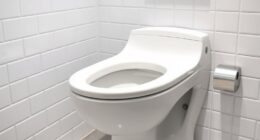Potable shower water is a necessity for daily hygiene. But have you ever wondered where it comes from and how it reaches your bathroom?
Groundwater and surface water are the primary sources of potable water. However, before it can be used, it requires treatment to ensure its safety. This treatment process can take place in private systems or public water supply plants. Regardless of the location, the extraction and filtration processes play a crucial role in making the water safe for use.
Once the water has been treated, it is then distributed to communities through a complex system. This distribution system consists of primary and secondary feeders, which carry the water from the treatment plants to the various neighborhoods and households.
In your house, the shower water supply system connects to the main supply. This connection allows for a mix of hot and cold water to be provided for a refreshing shower.
Overall, the journey of potable shower water involves multiple steps, from the initial source to the treatment process, and finally to your bathroom.
Key Takeaways
- Potable shower water can be sourced from groundwater found in aquifers and surface water from rivers, lakes, springs, and streams.
- Water extraction systems involve drilling boreholes and using water pumps for private use, while public water supply is treated in water treatment plants.
- The water distribution system consists of primary and secondary feeders that carry water from treatment plants to community areas and then to individual houses.
- Public water storages, such as raised white concrete tanks, are used for emergency water storage in cases of water shortage or blockage in the external supply line.
Sources of Potable Water
The sources of potable water for showering include groundwater from aquifers and surface water from rivers, lakes, springs, and streams. Both sources need to meet water quality standards to ensure safe usage.
Groundwater, obtained through drilling wells and using water pumps, is susceptible to contamination from various sources, such as industrial activities, agricultural practices, and improper waste disposal. Groundwater contamination can lead to the presence of harmful substances, such as heavy metals, pesticides, and bacteria, which can pose serious health risks.
Surface water, on the other hand, requires treatment before it can be used for household purposes. Treatment processes, such as chemical disinfection and filtering membranes, are employed in water treatment plants to remove impurities and ensure the water meets the necessary quality standards for showering and other domestic uses.
Water Extraction and Filtration
Public and private water extraction systems involve drilling boreholes and using water pumps for filtration purposes. These systems are essential for obtaining potable water from both surface and groundwater sources.
Water treatment processes play a crucial role in ensuring that the water supplied to households is safe for consumption. Filtration is of utmost importance in removing impurities and contaminants from the water. Various methods, such as chemical disinfection and filtering membranes, are used in water treatment plants to purify the water.
Filtration not only improves the taste and odor of the water but also removes harmful bacteria and viruses. Without proper filtration, the water could pose health risks to consumers. Therefore, the importance of filtration in water extraction and treatment cannot be emphasized enough.
Water Distribution System
Primary feeders carry water from treatment plants to community areas. This crucial component of the water distribution infrastructure ensures that potable water reaches households efficiently.
The maintenance of the water supply system is of utmost importance to ensure uninterrupted water flow. Regular inspections and repairs are necessary to prevent leaks and blockages, which can disrupt the supply.
Additionally, water treatment plants must be properly maintained to ensure the quality of the water being distributed. This includes monitoring and adjusting chemical disinfection processes, replacing filtering membranes as needed, and conducting routine water quality tests.
Public Water Storages
Raised white concrete tanks serve as emergency water storage and provide a backup solution in case of water shortage or blockage in the external supply line. These tanks play a crucial role in ensuring a continuous supply of water during emergencies.
The tanks are designed to hold a significant amount of water, which can be used for various purposes such as drinking, cooking, and sanitation.
One of the key benefits of these tanks is their ability to collect rainwater. The tanks are equipped with a system that allows rainwater to be collected and stored for future use. This helps in conserving water and reducing dependence on external water sources.
The stored water in these tanks acts as a reliable backup during times of water scarcity or when the external water supply is disrupted. It ensures that households have access to clean and safe water even in challenging situations.
Overall, these public water storages are an essential component of the water distribution system, providing a vital lifeline during emergencies and supporting sustainable water management practices.
Shower Water Supply System in the House
Connected to the main supply and equipped with hot and cold water lines, the showerhead in the house mixes the water for a comfortable showering experience.
Proper maintenance of the showerhead is essential to ensure its optimal performance. Regular cleaning is necessary to prevent the buildup of mineral deposits and bacteria, which can affect water flow and quality. To clean the showerhead, remove it from the shower arm and soak it in a mixture of vinegar and water. Scrub away any residue and rinse thoroughly before reattaching it.
Additionally, controlling water pressure is crucial for an enjoyable shower. Adjusting the water pressure can be done by installing a pressure regulator or by adjusting the showerhead’s flow restrictor.
Conclusion
In conclusion, the sources and distribution of potable shower water are vital for ensuring a safe and reliable water supply.
Groundwater and surface water are the main sources, requiring treatment through chemical disinfection and filtering membranes.
Public water supply systems and private extraction methods play a crucial role in distributing water to communities. Water storage tanks provide backup during emergencies or supply disruptions.
Within the house, the shower water supply system connects to the main supply and mixes hot and cold water. This intricate network ensures the availability of clean and refreshing shower water.
It’s like a lifeline that quenches our thirst for cleanliness and rejuvenation.










